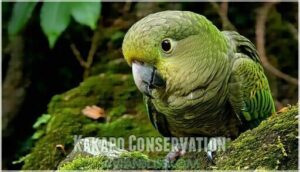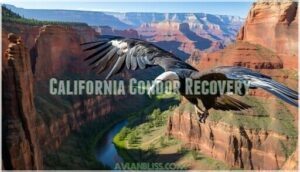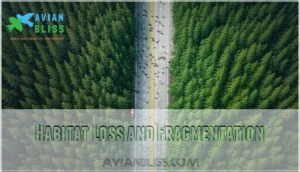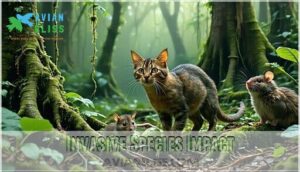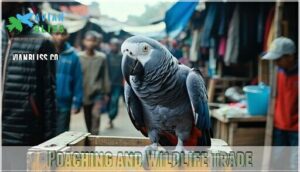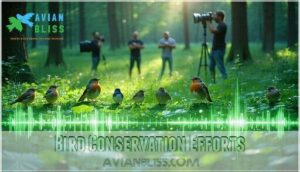This site is supported by our readers. We may earn a commission, at no cost to you, if you purchase through links.
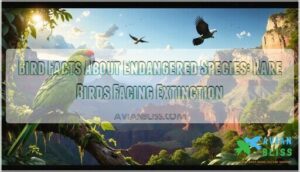
The Kakapo, a flightless parrot from New Zealand, has fewer than 250 individuals due to habitat loss and predators.
California Condors, once nearly extinct, are slowly rebounding thanks to captive breeding programs.
Sadly, the Hyacinth Macaw, the largest flying parrot, faces habitat destruction in South America.
Climate change, poaching, and deforestation threaten species like the Yellow-Crested Cockatoo.
Conservation efforts, from reintroducing birds to restoring habitats, are making a difference.
These feathered wonders remind us how fragile biodiversity can be—and why there’s always more to uncover about their survival.
Table Of Contents
- Key Takeaways
- Endangered Bird Species
- Threats to Birds
- Bird Conservation Efforts
- Critically Endangered Birds
- Global Bird Extinction
- Frequently Asked Questions (FAQs)
- What are 5 facts about endangered species?
- What are the top 3 killers of birds?
- Which birds are endangered?
- How many birds are at risk of extinction?
- Are humans destroying the world’s most endangered bird species?
- Which birds have suffered the most extinctions?
- Where are seabirds most endangered?
- What makes a species endangered?
- What is the #1 most endangered bird?
- What is the #1 threat to birds in America?
- Conclusion
Key Takeaways
- You can help protect endangered birds like the Kakapo and California Condor by supporting habitat restoration, captive breeding, and anti-poaching efforts.
- Habitat loss, invasive species, poaching, and climate change are the biggest threats pushing many bird species, such as the Hyacinth Macaw and Yellow-Crested Cockatoo, to the brink of extinction.
- Small actions, like joining conservation programs or promoting awareness, play a huge role in saving endangered birds like the Bali Mynah and Blue-Throated Macaw.
- Over 12% of the world’s bird species are at risk of extinction; addressing human-driven challenges like urbanization and deforestation is essential to their survival.
Endangered Bird Species
Endangered bird species face numerous challenges, from habitat loss to climate change, leaving many on the brink of extinction.
By understanding these threats, you can help support conservation efforts to protect these remarkable creatures.
Supporting conservation efforts today ensures these remarkable birds thrive tomorrow—together, we can protect nature’s most vulnerable wings.
Kakapo Conservation
The critically endangered Kakapo, a flightless, nocturnal parrot native to New Zealand, has rebounded thanks to dedicated conservation efforts.
Known scientifically as Strigops habroptilus, it thrives on island sanctuaries.
Conservation programs tackle challenges like the genetic bottleneck and limited breeding success, with a focus on a specialized Kakapo diet and future outlook that emphasizes sustainable growth, ensuring these unique birds remain a marvel among endangered species.
Kiwi Population Decline
Kakapo conservation reminds us how predator introduction and habitat destruction harm unique species.
Kiwi, or Apteryx, face serious challenges—from a genetic bottleneck to disease susceptibility.
Habitat loss and predators like stoats or dogs devastate bird populations.
Fortunately, initiatives like Operation Nest Egg and Kiwis for Kiwi Trust offer hope through:
- Predator control programs
- Captive breeding
- Monitoring efforts
- Public awareness campaigns
California Condor Recovery
The California Condor, Gymnogyps californianus, has soared back from near extinction thanks to captive breeding at places like the San Diego Zoo.
This North American giant faces lead poisoning and reintroduction challenges, yet efforts have grown its population to over 400.
With careful genetic diversity management and habitat efforts, its future outlook looks brighter—proof conservation works wonders.
Hyacinth Macaw Habitat Loss
The California Condor isn’t the only endangered bird facing challenges—Hyacinth Macaws are battling habitat loss driven by cattle ranching, soy expansion, and mining impacts.
These deforestation drivers disrupt habitat connectivity and nesting grounds. Habitat restoration is essential for their survival, and can be learned more about through Habitat restoration.
- Palm-rich habitats are essential but shrinking fast.
- Fires worsen food scarcity.
- Deforestation reduces nesting sites.
- Protecting macaws needs urgent bird conservation efforts.
Yellow-Crested Cockatoo Threats
Shifting focus from the Hyacinth Macaw, the Yellow-Crested Cockatoo faces relentless challenges.
Habitat destruction and deforestation impact their survival, while the cage-bird trade decimates populations.
Their numbers, estimated at 1,200-2,000, dwindle as wildlife trade and poaching disrupt nesting.
Conservation urgency is critical for one of the most endangered birds, as habitat loss and disease amplify threats to this remarkable species.
Threats to Birds
You might be surprised to learn how human actions, like habitat destruction and pollution, threaten birds worldwide.
Invasive predators, climate change, and illegal trade make survival even tougher for these vulnerable species.
Habitat Loss and Fragmentation
Habitat loss and fragmentation are leading threats to endangered birds.
Deforestation impacts nesting sites, urbanization effects disrupt migration paths, and agricultural expansion destroys ecosystems.
Fragmentation consequences, like broken habitat corridors, leave birds isolated and threatened.
Protecting their homes guarantees survival. Imagine building a house, only for someone to move your walls—bird conservation prevents that chaotic shuffle for threatened species.
Invasive Species Impact
Invasive species wreak havoc on bird populations, especially in island ecosystems.
Predator introduction, like feral cats and rats, preys on eggs and chicks, while competition effects disrupt food sources.
Disease transmission further endangers birds, leading to extinction risks.
These ecosystem disruptions amplify habitat loss, making bird conservation essential.
Protecting endangered birds means addressing these bird threats with bold, science-driven solutions.
Climate Change Effects
Extreme weather, altered migration, and habitat shifts caused by climate change wreak havoc on endangered birds.
It disrupts breeding cycles, increases disease spread, and leads to extinction risks.
Here’s how:
- Rising temperatures force birds to cooler areas, shrinking habitats.
- Breeding disruptions result from changing seasons.
- Disease spreads faster in warmer climates.
- Habitat loss worsens from rising sea levels, leading to extinction risks and habitat loss.
Poaching and Wildlife Trade
Illegal pet trade fuels a booming wildlife market, threatening endangered birds like the African Grey Parrot, whose populations plummet due to poaching.
Market demand drives harvesting, with entire trade routes designed for smuggling.
Conservation economics highlights poaching deterrents, including education and stricter laws, making bird conservation urgent to disrupt these harmful practices, as every captured bird symbolizes a system fail.
Pollution and Pesticide Use
Pollution creates invisible traps for endangered birds.
DDT impact, lead poisoning, and agricultural runoff poison food sources, weakening species like the California Condor.
Microplastic ingestion harms seabirds, while bioaccumulation effects ripple through ecosystems, magnifying pesticide use dangers.
Protecting bird habitats from these threats isn’t rocket science—simple bird conservation efforts like cleaner farming and less toxic alternatives can save countless lives.
Bird Conservation Efforts
You can help protect endangered birds through actions like supporting habitat restoration and captive breeding programs.
These strategies, combined with anti-poaching efforts and community-based conservation, guarantee threatened species have a fighting chance at survival.
Habitat Restoration and Protection
To tackle habitat loss, habitat restoration focuses on reforestation efforts, land acquisition, and creating protected areas.
You’d be amazed how corridor creation connects fragmented bird habitats, letting endangered birds thrive.
Habitat management guarantees resources stay healthy and available.
Consider exploring habitat restoration supplies for your own conservation efforts.
Bird conservation starts with these steps, proving a little green can go a long way in saving feathered friends!
Captive Breeding Programs
When protecting endangered birds, captive breeding programs act as life rafts.
They guarantee genetic diversity, addressing program success rates and reintroduction challenges head-on.
Ethical considerations are absolutely crucial—they balance species survival with nature’s rhythms.
To boost long-term sustainability, these efforts rebuild dwindling populations, aiding bird conservation, and reintroduction programs face hurdles, but hope springs as conservation efforts align with nature’s resilience.
Anti-Poaching Measures
Stopping poaching involves creativity and tech. Think drone surveillance spotting illegal activity, GPS tracking tagging endangered birds, and AI cameras identifying poachers.
Add heavy penalties enforcement to deter criminals. These anti-poaching measures, paired with community involvement, guarantee bird protection.
Consider using drones for conservation to aid in these efforts. By combining sharp-eyed technology and conservation efforts, you help give vulnerable species a fighting chance against extinction.
Small actions save wings!
Community-Based Conservation
Community-based conservation empowers people to protect endangered birds through local involvement and sustainable practices.
Encouraging community ownership, ecotourism benefits, and education programs fosters shared responsibility.
By restoring habitats and engaging locals, conservation efforts gain momentum.
Bird conservation organizations collaborate with residents, blending traditional knowledge and sustainable strategies, ensuring endangered species thrive while communities benefit.
One vital aspect involves citizen scientists collecting data to inform conservation strategies.
It’s teamwork for birds and biodiversity, with a focus on community-based conservation and sustainable practices that support endangered species.
Research and Monitoring
Research and monitoring are essential for protecting endangered birds.
They help track population dynamics and map habitats.
Here’s how they work:
- Use tracking technologies like GPS to study bird movements.
- Conduct genetic studies to maintain species diversity.
- Monitor bird populations to identify threats.
Modern conservation efforts utilize advanced tracking products for endangered birds.
- Evaluate conservation effectiveness to improve strategies.
These efforts keep bird species soaring with the help of advanced tracking products and by using tracking technologies to maintain species diversity.
Critically Endangered Birds
You’ll find critically endangered birds on the brink of extinction, facing immense threats like habitat loss, poaching, and invasive species.
These species, including the African Grey Parrot and Bali Mynah, rely on urgent conservation efforts to survive.
African Grey Parrot Population
The African Grey Parrot, a marvel of Psittacidae famed for its intelligence, faces steep population drops due to the pet trade’s impact and habitat degradation.
Once common in equatorial Africa, populations like the Congo and Timneh African Greys now plummet.
Conservation strategies focus on halting illegal cage bird trade, while low population genetics complicate efforts.
The future outlook hinges on intensive protections.
Araripe Manakin Habitat
The Araripe Manakin lives in Brazil, relying on streams and lush greenery in a small forest patch.
Habitat loss from deforestation and poor water quality threatens its survival. Conservation efforts like reforestation and maintaining habitat connectivity aim to counter forest fragmentation.
Climate impact adds pressure, yet preserving these endangered birds highlights the importance of protecting unique ecosystems and delicate species.
Bali Mynah Conservation
The Bali Mynah, or Bali starling, teeters on extinction with fewer than 100 left in the wild.
Conservation efforts focus on:
- Captive Breeding: Boosts genetic diversity for reintroduction programs.
- Habitat Protection: Safeguards nesting spots on Indonesia’s islands.
- Poaching Prevention: Combats illegal wildlife trade.
- Ecotourism Impact: Funds critical conservation projects, ensuring survival for one of the world’s rarest birds.
These efforts align with habitat restoration strategies to improve the bird’s natural environment.
Bengal Florican Threats
The Bengal Florican, one of Asia’s critically endangered birds, faces immense threats due to habitat loss.
Development encroachment and grassland degradation have turned its grassland homes into farmland. Hunting pressure and pesticide impact further shrink its numbers.
Invasive species also disrupt ecosystems vital for survival. Habitat conversion urgently needs addressing to save this elegant bird from vanishing forever, due to the significant impact of human activities.
Blue-Throated Macaw Status
The Blue-Throated Macaw, one of the most endangered birds, has around 400 individuals left due to habitat loss and illegal capture.
Conservation efforts, like breeding program success and habitat protection urgency, offer hope.
Threat mitigation strategies include protecting nests and engaging locals.
Saving this critically endangered parrot depends on future conservation outlooks addressing environmental challenges, and Time’s ticking!
Global Bird Extinction
You’re living in a world where nearly 1 in 8 bird species faces extinction due to threats like habitat loss, climate change, and poaching.
Nearly 1 in 8 bird species teeters on extinction—protect their habitats today to ensure a thriving future for tomorrow’s skies.
Understanding global bird extinction helps you see how human activities impact biodiversity and why conservation efforts are essential.
Extinction Rates Among Birds
Bird extinction rates highlight worrying trends.
Scientists use past extinctions to gauge current threats.
Today’s avian extinction stems from habitat loss, climate change, and poaching.
Here’s how the figures stack up:
- Past extinctions: Over 150 bird species lost since 1500.
- Current trends: Over 12% of birds are now threatened.
- Future projections: Entire populations face risks daily.
- Conservation impact: Effective efforts save endangered birds.
Geographic Distribution of Endangered Birds
Endangered birds often cluster in "continental hotspots" like South America or Southeast Asia, where habitat loss runs rampant.
Island endemics, such as Hawaii’s rare species, face harsh threats from invasive predators.
Migratory patterns and range shifts complicate geographic distribution, highlighting habitat specificity. These shifts force bird populations to adapt quickly, but not all bird species can keep up with their changing environments, leading to a critical situation of endangered birds.
Human Impact on Bird Populations
As habitats shrink from urbanization and agricultural expansion, endangered birds face growing challenges.
Deforestation impacts nesting sites and food sources, while pollution sources poison ecosystems.
Climate change worsens habitat loss and alters migration. Agriculture impacts on 73% of threatened bird species.
Here’s how human impact unfolds:
- Clearing forests disrupts bird populations.
- Farms replace wetlands, key for birds.
- Pollution contaminates food chains.
This reorganization aims to highlight the critical challenges faced by endangered birds due to human activities.
International Cooperation for Conservation
International cooperation is the backbone of protecting endangered birds.
Transboundary conservation helps manage shared resources across borders, while global treaties like CITES regulate wildlife trade.
Collaborative research identifies solutions to habitat loss and invasive species threats.
Securing funding mechanisms guarantees these efforts succeed.
By uniting globally, we’re proving that conserving biodiversity isn’t just idealistic—it’s absolutely doable, and this is achieved through global cooperation.
Conservation Strategies and Solutions
Every effort counts, especially when saving rare birds.
Conservation strategies like habitat restoration and sustainable agriculture benefit ecosystems and endangered birds alike.
Organizations promote genetic rescue methods and policy changes that strengthen protections.
You can even help by supporting eco-tourism projects, which fund conservation efforts.
Together, we sustain essential ecosystem services and give these remarkable species a fighting chance.
Frequently Asked Questions (FAQs)
What are 5 facts about endangered species?
Some species can’t survive without our help.
Habitat loss, poaching, invasive predators, and climate change are their biggest threats.
Conservation efforts like habitat restoration, captive breeding, and anti-poaching programs are essential to saving them from extinction.
What are the top 3 killers of birds?
Think of birds as fighters in nature’s ring—habitat loss, invasive species, and climate change are the top contenders knocking them out.
Forest destruction, predators like cats, and shifting weather patterns threaten their survival worldwide, highlighting the impact of climate change.
Which birds are endangered?
Some endangered birds include Kakapo, California Condor, Bali Mynah, Hyacinth Macaw, and Bengal Florican.
Their numbers are dwindling due to habitat loss, poaching, invasive species, and climate change.
Conservation efforts are essential to their survival.
How many birds are at risk of extinction?
Around 12% of the world’s bird species, totaling over 1,200 types, face extinction risks due to habitat loss, climate change, invasive predators, and illegal hunting.
These challenges make survival an ongoing battle.
Are humans destroying the world’s most endangered bird species?
You’d be surprised to know 12% of all bird species face extinction.
Habitat destruction, invasive predators, and illegal poaching are mostly human-driven.
It’s like we’re unintentionally writing their final chapters—time to change that story.
Which birds have suffered the most extinctions?
Passenger pigeons, dodos, and great auks suffered devastating extinctions due to overhunting and habitat loss.
Human actions, like overexploitation and habitat destruction, have wiped out these once-abundant species, leaving behind cautionary tales for conservation.
Where are seabirds most endangered?
Seabirds face the highest threats on remote islands and coastal regions impacted by invasive predators, pollution, and overfishing.
Places like Hawaii and New Zealand’s islands are hotspots, where invasive species destroy nests and habitats rapidly, posing a significant threat to seabirds, especially in areas affected by invasive predators.
What makes a species endangered?
When a species is endangered, it’s like teetering on the edge of a cliff—facing threats like habitat loss, predators, or climate change.
Their numbers drop dangerously low, making survival and reproduction increasingly difficult, which is a critical issue due to climate change.
What is the #1 most endangered bird?
The Kakapo is the world’s most endangered bird.
This flightless, nocturnal parrot from New Zealand has only about 250 individuals left, mainly due to habitat loss, invasive predators, and its low genetic diversity.
What is the #1 threat to birds in America?
Imagine a tree losing its roots.
In America, habitat loss is the biggest threat to birds.
Urban sprawl, agriculture, and deforestation keep destroying their nesting sites, leaving them vulnerable and struggling to survive.
Conclusion
It’s ironic how we often marvel at birds’ beauty yet overlook their struggles.
Learning bird facts about endangered species reveals their dire reality. These feathered wonders face threats like habitat destruction, poaching, and climate change.
Yet, conservation efforts—habitat restoration, captive breeding, and anti-poaching programs—offer hope. Your curiosity sparks awareness, and awareness inspires action.
By protecting these rare birds, you’re preserving biodiversity and the intricate ecosystems they support. There’s still time to make a difference!
- https://journals.plos.org/plosone/article?id=10.1371/journal.pone.0166307
- https://www.iucnredlist.org/species/22685245/129751169
- https://www.doc.govt.nz/
- https://www.earth.com/earthpedia-articles/the-12-endangered-birds-most-at-risk-of-extinction/
- https://blogs.scientificamerican.com/running-ponies/new-zealands-little-spotted-kiwi-birds-are-in-more-trouble-than-thought/

